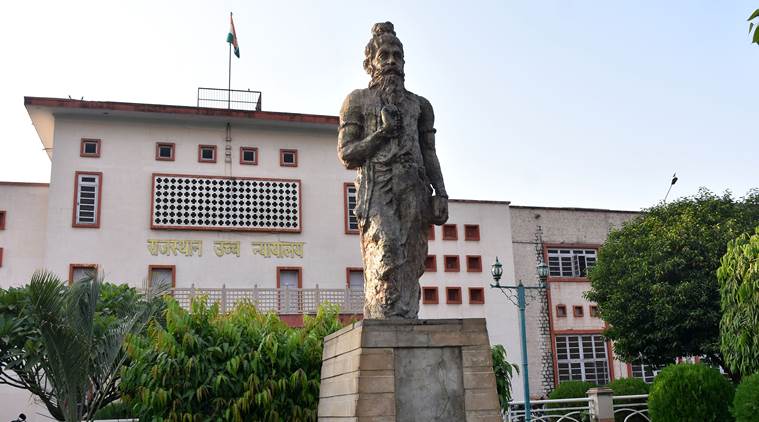 The statue of Manu inside the compound of the Rajasthan High Court in Jaipur. (File/Express photo by Rohit Jain Paras)
The statue of Manu inside the compound of the Rajasthan High Court in Jaipur. (File/Express photo by Rohit Jain Paras)
By Dhruv Jadhav and Aditya Wakhlu
We erect statues of freedom fighters and bygone kings, of politicians and mighty gods. We do so to glorify and to commemorate, or perhaps even to deify. In recent times, however, protesters across the world have laid siege to statues of personalities whose views are now considered ignorant and dated at best, and hateful at worst.
The subject of this constitutional obloquy is a statue of Manu placed on the premises of the Rajasthan High Court in 1989, holding in his hand his Manava-Dharmasastra or Manusmriti. The demand for its removal is grounded in the constitutional obligations of the state vis-a-vis the rights of the people.
Manu is regarded as the first law-giver of the Hindus. His Manusmriti finds a place in court judgments and public discourse and has become part of the zeitgeist for Hindu revivalists. This compendious tome prescribes the “sacred laws” of each varna of an ideal Vedic society — brahman, kshatriya, vaishya and shudra, with the rest being avarna.
The Manusmriti is not an ambiguous text: It explicitly dehumanises shudras and avarnas based on their birth. It states that the sole purpose of a shudra’s birth is to serve the other varnas (1.91). A shudra’s name must denote something contemptible (2.31); he must not amass wealth (10.129), or hear the Vedas (4.99), or receive education (4.80). A brahman may seize a shudra’s property (8.417), or compel him to work as a slave (8.413). Where a shudra interprets the law, the kingdom will sink like a cow in a morass (8.21). A chandala must live outside the village, wear the clothes of the dead, eat in broken dishes, and have dogs and donkeys as his only wealth (10.50-10.56). One who touches a chandala must purify himself by bathing (5.85).
The text is clear, and yet, the Manusmriti has its apologists who claim that the hierarchies it perpetuates are a corruption of the original text, that it speaks of varnas and not castes, and so on. These excuses, however, turn a blind eye to the fact that the Manusmriti has long been used to justify caste oppression, regardless of its original meaning. In fact, B R Ambedkar had burnt a copy of the Manusmriti in 1927, “as a protest against the system of social inequality it embodies in the guise of religion”.
The statue is not merely an expression of religious freedom of those who proposed it, or of the judges who approved it. On the contrary, it constitutes an expression on the part of the state. By allowing the use of its premises for this permanent expression, the High Court has tacitly sanctioned the content and import of a religious code which violates basic human dignity. The statue of Manu is not just a religious symbol, but also a symbol of discrimination, oppression and subjugation. As an expression of the state, it falls afoul of constitutional morality, and it also has a chilling effect on the right of the people to expect impartial justice.
The principles of equality, dignity and fraternity form the bedrock of constitutional morality, and the court as an organ of the state, has a bounden duty to uphold them. The state’s tacit approval of a religious code and its conception of morality that legitimises untouchability and caste stratification derogates from that duty. This is especially the case since the Constitution declares “untouchability” a crime, which is a rare occurrence. In fact, Section 7(1)(c) the Protection of Civil Rights Act, 1955 enforces this constitutional mandate by criminalising the promotion of “untouchability” by any visible representation. Thus, a statue of Manu in a temple of justice is an anathema to constitutional morality.
The glorification of Manu at the gates of the court may have a chilling effect on the right of historically oppressed minorities to expect impartial justice. It may give rise to an apprehension of discrimination. The presence of the statue may suggest that the court tacitly assents to the principles of the Manusmriti. In constitutional democracies, discrimination usually occurs in an insidious and structural fashion, but the statute of Manu stands as a visceral symbol of that discrimination for, unlike the statue of Lady Justice, the statue of Manu is not blind-folded.
There is, however, cause for hope from the Rajasthan High Court, which recently prohibited the mention of caste identifiers in judicial proceedings, stating that it violates the spirit of the Constitution.
Perhaps acknowledging the inequities that the statute is emblematic of, the Rajasthan High Court had ordered its removal within six months of it being placed in 1989. However, that order was never implemented since a PIL was filed to stall the same. This series of events may explain why protesters across the globe are choosing to topple statutes, rather than waiting for the law to take its course.
The writers are lawyers